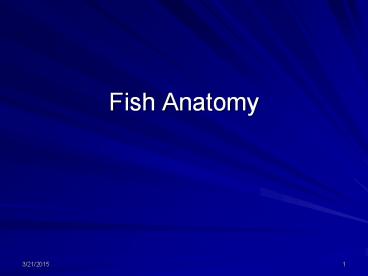Fish Anatomy PowerPoint PPT Presentation
1 / 20
Title: Fish Anatomy
1
Fish Anatomy
2
External
3
Internal
4
- SPINE Made up of numerous hollow vertebrae that
protect the spinal cord. - SPINAL CORD Connects brain to the rest of the
body and relays information from the body to the
brain and vice versa - BRAIN where both automatic functions (such as
respiration) and higher behaviors ("Should I eat
that critter with the spinning blades?") occur.
5
Internal
6
- LATERAL LINE 1 of the primary sense organs
detects underwater vibrations and determines the
direction of them - SWIM (or AIR) BLADDER A hollow, gas-filled
balance organ that allows a fish to conserve
energy by maintaining neutral buoyancy
(suspending) in water - GILLS
- Allow a fish to breathe underwater
7
Internal
8
- KIDNEY Filters liquid waste materials from the
blood also important in regulating water and
salt concentrations within body, allowing certain
fish species to exist in freshwater or saltwater
or both - STOMACH AND INTESTINES Digest food and absorb
nutrients - Bass that are piscivorous (eat other fish) have
fairly short intestines because such food is easy
to break down and digest. - Tilapia that are herbivorous (eat plants) require
longer intestines because plant matter is tough
and fibrous and more difficult to break down into
usable components
9
Internal
10
- VENT The site of waste elimination from the
fishs body - LIVER This important organ has a number of
functions. Assists in digestion by secreting
enzymes that break down fats, and also serves as
a storage area for fats and carbohydrates - HEART Circulates blood throughout the body.
Oxygen and digested nutrients are delivered to
the cells organs through the blood, and the blood
transports waste products from the cells to the
kidneys and liver for elimination
11
Internal
12
- GONADS (REPRODUCTIVE ORGANS) Bright orange mass
of eggs - The male organs, which produce milt for
fertilizing the eggs, are much smaller and white
but found in the same location - The eggs (or roe) of certain fish are considered
a delicacy (caviar sturgeon)
13
Internal
14
- MUSCLES Provide movement and locomotion
- This is the part of the fish that is eaten and
becomes the fillet of the fish
15
Correctly Measuring
16
- Catch and Release Chart
17
Fishing Facts
- Minnesota is first nationally in the sales of
fishing licenses per capita. - Fish species 158
- Fishing waters 3,800,000 acres
- Fishable lakes 5,493
- Fishable streams (cold and warm water) 15,000
miles - Trout streams 1,900 miles
- Trout stream improvements 410 miles
- Trout lakes rehabilitated 134
- Warm water lakes rehabilitated 79
18
- Average number of fish stocked per year
- Walleye Fry - 250 millionWalleye Fingerlings -
2.0 millionWalleye Yearlings - 54
thousandWalleye Adults - 32 thousand - Northern Pike (fry, fingerlings adults) - 1.2
million - Muskellunge (fingerlings) - 32,000
- Tiger Muskellunge (fingerlings) - 2,000
- Largemouth Bass - 7,500 (fingerlings and
adults)Smallmouth Bass - 30,000 (fingerlings and
adults) - Channel Catfish - 100,000 (fingerlings and
yearlings) - Bluegill - 40,000 adults
19
- Fish hatcheries 5 coldwater ( trout and salmon),
12 cool and warm water (walleye, muskie, catfish,
etc.) - Walleye rearing ponds used annually (on average)
325 - Northern pike spawning areas used annually (on
average) 10
20
Harvest
- Sport Fish HarvestedWalleye - 35 million
poundsNorthern Pike - 3.2 million poundsPanfish
- 64 million pounds - The most caught fish 1st Panfish 2nd
Walleye 3rd Northern - Sport fishing expenditures in Minnesota 1.58
billion - Commercial fish harvested 4.5 million pounds
- Minnow industryMinnow dealers 386Minnow
retailers 920

